The AMD Trinity Review (A10-4600M): A New Hope
by Jarred Walton on May 15, 2012 12:00 AM ESTAMD Trinity Gaming Performance
After the 3DMark results, you might be wondering if Intel has finally caught up to AMD in terms of integrated graphics performance. The answer is…yes and no. Depending on the game, there are times where a fast Ivy Bridge CPU with HD 4000 will actually beat out Trinity; there are also times where Intel’s IGP really struggles to keep pace. The good news is that at least everyone is now onboard the DX11 bandwagon, and compatibility with games has improved yet again for Intel. Here are our “Value” benchmark results for seven recent games; we’ll have more information in a moment.

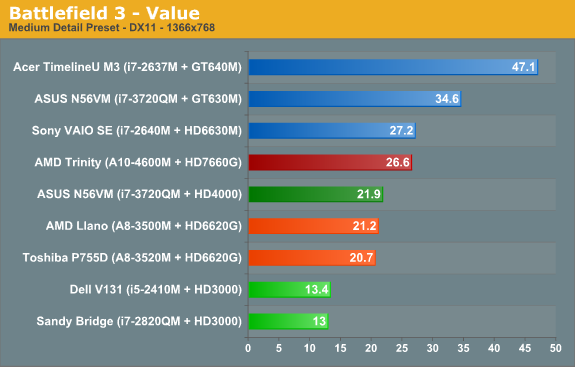
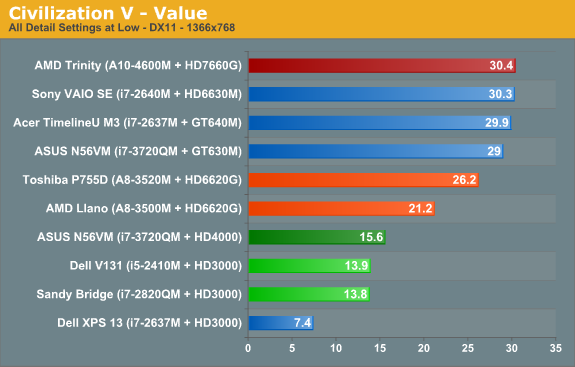

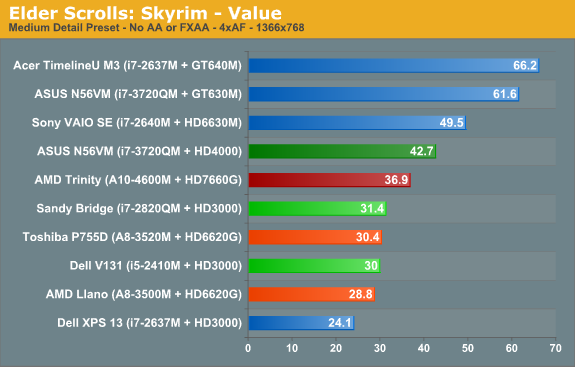
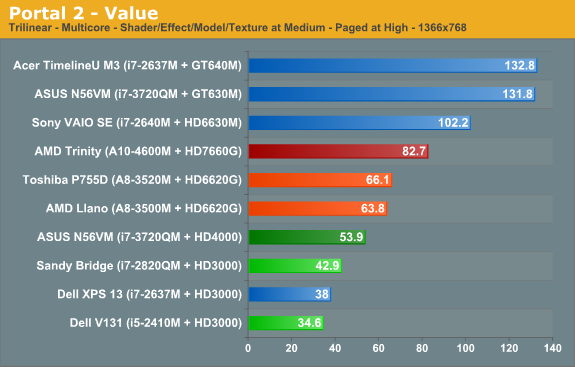
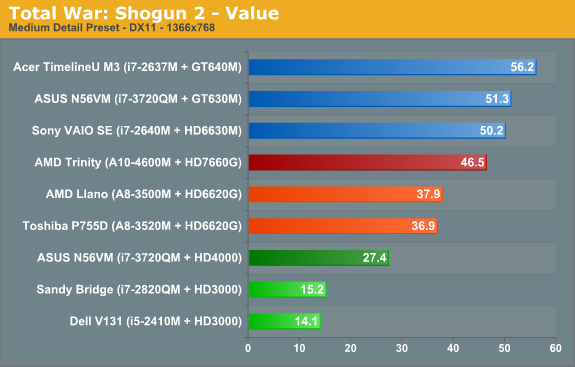
Out of our seven test titles, AMD’s Trinity leads any other IGP in four titles by a large margin. The other three titles actually have Ivy Bridge slightly ahead of Trinity, but the gaps aren’t nearly as big. Overall, the average performance across the seven games at our Value (medium) settings has AMD’s Trinity A10-4600M leading Intel’s i7-3720QM by 21%, and if we look at quad-core Sandy Bridge with HD 3000 (i7-2820QM) Trinity is 72% faster. Trinity is also around 20% faster than 35W Llano on average.
Let’s expand our gaming suite just a bit to see if things change, though. Just like we did with Ivy Bridge, we ran the eight games in our previous benchmark suite at medium detail settings. We can then compare performance across a wider 15 title selection to see how Trinity matches up against HD 4000, HD 3000, and HD 6620G (Llano). We’ll start with the bottom (HD 3000/Sandy Bridge) and move up.
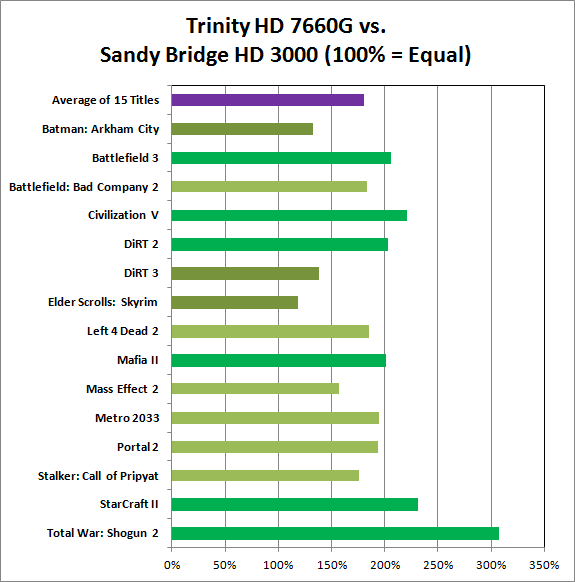
Llano’s HD 6620G was already faster than HD 3000, and Trinity’s HD 7660G is faster than Llano, so the Sandy Bridge gaming matchup is a landslide victory in AMD’s favor. The closest Intel can get is in the same three titles where Ivy Bridge leads Trinity: Batman: Arkham City, DiRT 3, and Skyrim. Here, however, HD 3000 can’t actually close the gap and HD 6620G is at least 20% faster than HD 3000, with an average performance improvement of nearly 80%.
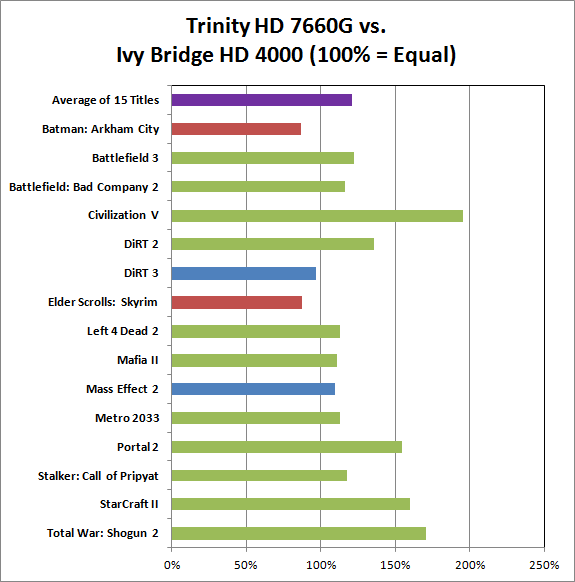
We found that across the same selection of 15 titles, Ivy Bridge and Llano actually ended up “tied”—Intel led in some games, AMD in others, but on average the two IGPs offered similar performance. This chart and the next chart will thus show a similar average increase in performance for Trinity, but the details in specific games are going to be different. Starting with Ivy Bridge and HD 4000, as with our earlier game charts we see there are some titles where Intel leads (Batman and Skyrim), a couple ties (DiRT 3 and Mass Effect 2), and the remainder of the games are faster on Trinity. Mafia II is close to our <10% “tie” range but comes in just above that mark, as do Left 4 Dead 2 and Metro 2033. The biggest gap is Civilization V, where Intel’s various IGPs have never managed good performance; Trinity is nearly twice as fast as Ivy Bridge in that title. Overall, it's a 20% lead for Trinity vs. quad-core Ivy Bridge.
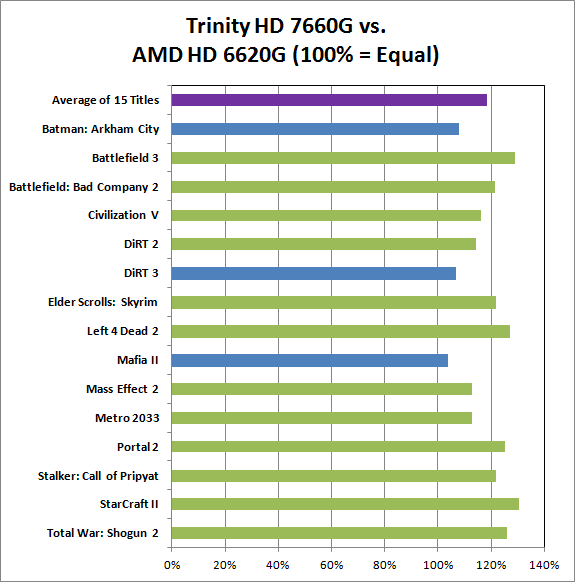
Against Llano, Trinity is universally faster, but the smallest gap is in Mafia II (3%) while the largest gap is in StarCraft II (30%). On average, looking at these games Trinity is only 18% faster than Llano. What’s not entirely clear from the above chart is whether we’re hitting CPU limitations, memory bandwidth limitations (remember that Llano and Trinity share bandwidth with the rest of the system), or perhaps both. At our chosen settings, what is clear is that Trinity’s “up to 56% faster” graphics never make it that high.
We saw 35-45% higher scores in 3DMark 11 and Vantage, which tend to remove the CPU from the equation more than actual games, so our guess would be that if AMD continues with their APU plan they’re going to need to work more on the CPU side of the equation. We also see the same thing looking at the VAIO SE scores in the earlier gaming charts: the HD 6630M scores are 20% faster on average, but much of that appears to come from the faster CPU rather than the GPU.










271 Comments
View All Comments
bji - Tuesday, May 15, 2012 - link
What exactly about the review turned you off from Trinity for HTPC purposes?Was it the good-enough-for-HTPC CPU performance?
The superior GPU performance?
The better power efficiency?
The lower power use?
The cooler GPU?
The lower price (than the i3 you mentioned)?
Honestly just curious about why you so summarily concluded that Trinity wouldn't be a good choice from your HTPC when I can't see anything in the article that would allow you to draw that conclusion.
Unless it was the CPU chart comparison against at 3x as expensive CPU that you would never use in an HTPC anyway?
cjs150 - Wednesday, May 16, 2012 - link
The main purpose will be as an HTPC, video transcoding is very important, look back to Jarred's review, Intel are winning by a large margin.For the case I intend to use as long as TDP is under 50W there are no concerns.
For me the i7-3770T will be the way to go. But you may want to try AMD. If I had built the HTPC last year there would have been no question that AMD would have been the right choice - Atom is/was useless. Maybe next year the table will turn again.
Spunjji - Wednesday, May 16, 2012 - link
Soooo... AMD are good against Atom, so you would have bought them then... but now you're buying an i7 with which they (obviously) cannot compete? That particular argument is a little difficult to follow, unless your requirements have drastically altered. :)To be fair to AMD, most people I know don't do transcodes while at the machine so speed isn't terribly relevant past a certain point, but I understand this may be different for you.
DellaMirandola13 - Tuesday, May 15, 2012 - link
I have really been looking forward to this review, nice to see a reasonably competitive CPU-market. Thank you.I am not a (serious) enthusiast, my best suit is lurking, but I was very excited to learn about the heterogeneous aspect. Is it possible you could elaborate or perhaps link to a comprehensive elaboration on the prospects of heterogeneous computing.
As far as I could tell, it seemed very useful in navigating within GIS-applications (particularly when you have to load roads or other kinds of grids on a map), but that's pure speculation.
Jedibeeftrix - Tuesday, May 15, 2012 - link
I would be interested in a 14" hp sleekbook if it comes with the 25w 4655M APU, as the full 384 shaders would be nice, otherwise I will wait till 28nm APU's arrive in 2013 sporting GCN.Ps test trinity with blender cycles.
Veroxious - Tuesday, May 15, 2012 - link
I am rather baffled by the fact that Ivy Bridge did not bring substantial battery life improvements with it 22nm process. Is it as a result of the trigate transistor tech? By extension when AMD moves to 22nm will it also be trigate seeing that they no longer have their own foundry? Has trigate given the purported benefits that were punted when it was announced, or is it simply a case of the 22nm node not being mature enough?JKnows - Tuesday, May 15, 2012 - link
It would be nice to see those game test in High settings! My personal tests shows in high details settings Llano faster than HD4000, Trinity should be much faster.tipoo - Tuesday, May 15, 2012 - link
This is true. The HD4000 falls further and further behind as you increase the detail settings; that's where AMDs implementation shines.JarredWalton - Tuesday, May 15, 2012 - link
Go look at Mobile Bench: the results for our "High 900p" testing is in there.http://www.anandtech.com/bench/Product/600?vs=580
But just to summarize, at 900p "High" settings, Trinity's lead over HD 4000 grows to 26% in our seven "2012 Suite" games. Also worth note is that Trinity is >30 FPS in three titles (DiRT 3, Portal 2, and Total War: Shogun 2) while Ivy Bridge is >30 FPS only in DiRT 3 (but comes very close in Skyrim).
Alexko - Tuesday, May 15, 2012 - link
"I’d say AMD GPUs as well, but I’m still waiting for a better switchable graphics solution."You mean like Enduro?